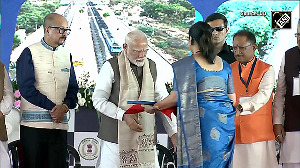Notice something? The discernible Burberry checks and Louis Vuitton Murakami symbols are no longer conspicuous in downtown Mumbai's shopping centres.
Amusingly enough, you are still wooed with illicit calls of 'Balenci' (Balenciaga) or 'Mulberry' handbags. Look closely, though, and these are distorted-name lookalikes (the old 'Lifeboy' syndrome).
According to a luxury report released by the retail consultancy Technopak, luxury clothing and accessories account for 28 per cent of the $14.4-billion total luxury spend in India.
As luxury labels descend on India to seize the potential (import duty is just 35 per cent), and the rich Indian responds with wide eyes, a question mark dangles over counterfeits.
"Representatives from a couple of companies have been coming here regularly for the last year and confiscating all our stock," groans one retail assistant at a shopping centre.
This shop, along with two others, was dragged to court last year as the retail whispers have it, by L V Trading India, authorised distributors of LVM goods on charges of copyright infringement.
Tikka Shatrujit Singh, brand advisor, Louis Vuitton India, does not deny this. "We've hired a specialist Intellectual Property law firm to assist in our clean-up of the fake goods market," he says.
Singh is particularly pleased with the government's proactive involvement in the endeavour. So is Charu Sachdev, CEO, TSG Marketing, that represents Moschino in India.
"The police and government have been guaranteeing complete and effective protection in cases of brand infringement and piracy," says S R Arun, partner, ALMT Legal, who has assisted Gillette and Seagram's in trademark violation suits, "The proceedings are straightforward, but evidence collection needs to be meticulous this can swing success either way."
China is the origin of most fakes that make their way into India. In a bid to display its tough stance on Intellectual Property Rights, Chinese officials recently announced the shutting down of Shanghai's booming Xiangyang Market in June.
In another landmark event last year, LVMH, Prada Holding and Burberry Group among others, successfully sued a Silk Alley (Beijing's centre for fake luxury goods) landlord for knockoff products sold on his premises. The case is currently on appeal.
Gangu Batra, CEO of Jashanmal National Company, franchisee for Burberry in India, expects to see similar crackdowns in India.
But are these fakes really hurting bonafide luxury sales? Well, the brand, if not sales. "It is not so much a direct loss of revenue as it is a loss of brand image," says Batra. "It's a grossly unfair exploitation of the brand's heritage," adds Singh.
Counterfeit retailers, however, don't see their point. "The two markets are totally different those who go in for fakes would never buy the real thing so why deprive them," asks a visibly harried retailer.
Just how effective the crackdown will prove is another question. According to Arun, on past precedent, crackdowns tend to send counterfeits underground for a while.
"Predominantly," he says, "India is not the source of manufacturing, therefore, the trade does make its way back. But periodic raids have in the past had considerable impact on the industry."
For now, the mood in Mumbai's Dharavi, India's largest hub for fake leather goods, is pensive. Unlike earlier, a walkthrough reveals barely a few fakes on display (just the odd Gucci peeking out). Thus do the noticeability rules of the game change.







 © 2025
© 2025